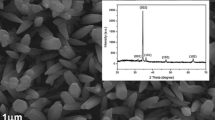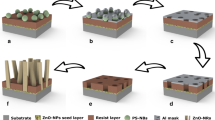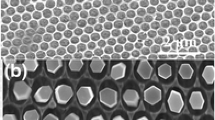Abstract
A hybrid technique for the selective growth of ZnO nanorod arrays on wanted areas of thin cover glass substrates was developed without the use of seed layer of ZnO. This method utilizes electron-beam lithography for pattern transfer on seedless substrate, followed by solution method for the bottom-up growth of ZnO nanorod arrays on the patterned substrates. The arrays of highly crystalline ZnO nanorods having diameter of 60 ± 10 nm and length of 750 ± 50 nm were selectively grown on different shape patterns and exhibited a remarkable uniformity in terms of diameter, length, and density. The room temperature cathodluminescence measurements showed a strong ultraviolet emission at 381 nm and broad visible emission at 585–610 nm were observed in the spectrum.
Similar content being viewed by others
Introduction
One-dimensional (1D) ZnO nanostructure arrays aligned on substrates are highly desirable for promising device applications. For example, it has been demonstrated that ZnO nanorod/nanowire arrays on proper substrates can emit ultraviolet laser at room temperature [1], enhance biofluorescence detection [2], act as piezoelectric nanogenerators [3], and can be used to construct nanowire dye-sensitized solar cells [4]. Moreover, ZnO nanorod arrays (NRAs) are expected to find potential applications as nano-optoelectronic devices [5–11]. For the growth of aligned and quasi-aligned ZnO NRAs on substrates, various low temperature solution-phase approaches have recently been developed because of their good potential for scale-up production and commercial feasibility. A selective area growth of well-aligned ZnO nanostructures has also been achieved using various techniques like template-directed approach [12], nanosphere lithography [13], polystyrene microsphere-based self-assembly monolayers [14], silane-based self-assembled monolayers [15], and conventional photolithography [16]. However, these patterning methods require expensive mask, complex multi-step processes, and metal catalysts in some cases, and deposition of seed layer on substrates. In general, it is known that the seed layer of ZnO is required for the growth of ZnO nanorods without the use of catalyst.
The ability to control the nanorod orientation and position during the growth is critically important, because it allows the growth and assembly of nanorods to be combined into one step, facilitates the subsequent fabrication processes such as the formation of electrical contacts to nanorods and opens up the design space for novel devices. Achieving spatially, specific, selective, highly ordered, and uniform growth of ZnO NRAs on wanted areas of substrates via a one-step approach by solution method without using seed layer remains a prominent challenge, although impressive progresses have been made using seeded substrates [17, 18].
In this paper, we report the growth of quasi-aligned ZnO NRAs on a thin cover glass substrate in solution without the use of any seed layer. The position and location of NRAs was controlled by electron-beam lithography patterns. The ZnO NRAs were grown on the patterned cover glass substrate in solution at 90 °C. We chose cover glass substrate to grow NRAs because it possesses many attractive properties including biocompatibility, lightweight, and transparency. Particularly, the ZnO NRAs on cover glass open a wide variety of application; examples are enhancement of fluorescence detection, single native DNA molecule detection and can act as novel carriers for mammalian cell transfection [2, 19].
Experimental
The nanofabrication process used in this work was accomplished in four steps as shown in Fig. 1: (a) thin layer of resist polymer spun over cover glass substrate; (b) electron-beam writing; (c) growth of ZnO nanorods arrays in solution; and (d) lift-off resist material and residue from the substrate. Polymethylmethacrylate (PMMA) was used as electron-beam resist material and spin-coated over the substrate. After writing, the patterned substrates were developed in a solution of methyl isobutyl ketone and isopropyl alcohol (volume ratio of 1:3) for 30 s. For the growth of ZnO nanostructures on the patterned substrates, 10 mM aqueous solution of zinc nitrate hexahydrate (Zn(NO3)26H2O, Sigma–Aldrich) and water-soluble hexamethylenetetramine (C6H12N4, Sigma–Aldrich) were used as reagents. In a typical reaction, the pH of solution was kept at 6 ~ 7. The pre-patterned cover glass substrates were immersed in the solution, and the temperature of flask was kept constant at 90 °C for 6 h. After the successful growth of nanorods, the electron-beam resist material was lifted off from the substrate using organic solvents. The surface morphologies of as-grown ZnO nanorod arrays were examined by field emission scanning electron microscopy (FESEM), (FESEM, Hitachi, Japan). An X-ray diffractometer (XRD) (Rigaku III/A, Japan) was used to analyze crystal phase and crystallinity of ZnO NRAs. X-ray wavelength used in the analysis was 0.154 nm of Cu Kα. The room temperature cathodluminescence (CL) spectra and images were taken using CL system equipped on a high resolution FESEM (FESEM, Hitachi, Japan).
Schematic illustration of selective growth process of ZnO nanorod arrays: a thin layer of resist polymer (PMMA) spun over cover glass substrate; b pattern transfer by electron-beam lithography; c growth of aligned ZnO nanorod arrays in solution, and d lift-off resist material and residue from the substrate
Results and Discussion
Figure 2 shows the FESEM images of ZnO NRAs, selectively grown on cover glass substrates. The interdistance between two strips is kept 3 μm, and each strip has length of 20 μm (a). The magnified image of (a) clearly identifies high degree site-selective growth of NRAs (b). The gap between the two strips and length of patterns was same; however, the patterned site further reduced to 1.5 μm and shown in (c). As can be seen in the magnified FESEM images of ZnO NRAs (b and d), the patterned sites are fully occupied with ZnO nanorods. The ability to scale up the pattern to a larger size has also been examined. Figure 2e shows the low-magnification FESEM image of large size square-shape pattern (100 × 100 μm), where each white spot represents the patterned ZnO NRAs. The inset image of Fig. 2e shows ZnO nanorods on a thin cover glass substrate. The magnified image (f) represents that each nanorod exhibits hexagonal nanotip. The inset in (f) represents a magnified square pattern of 4 μm × 4 μm. It can be seen that high-density NRAs were grown only on both microstrip and microsquare patterns, while no NRAs were grown in the interstrip and intersquare areas. Each nanorod has a diameter of 60 ± 10 nm and length of 550 ± 50 nm, respectively. More interestingly, these quasi-aligned ZnO NRAs on different shape patterns exhibit remarkable uniformity in terms of diameter, length, and density since they are grown under same experimental conditions.
Figure 3a shows the XRD pattern of the ZnO NRAs selectively grown on pre-patterned cover glass substrates. A sharp, strong, and dominant peak of ZnO (0002) at 34.24° observed, indicating that the synthesized nanorod arrays are single crystalline in nature and grown along the c-axis direction. Moreover, the strong intensity of (0002) reflection with narrow width also exhibits that the ZnO NRAs are well oriented along the normal direction of the substrate surface, which is almost consistent with the FESEM observations. TEM image of a ZnO nanorod is presented in Fig. 3b, and SAED pattern of ZnO nanorod is represented as Fig. 3c. These results confirmed that the ZnO NRAs were single crystal in nature.
ZnO nanorods were formed by the hydrolysis of zinc nitrate hexahydrate in water in the presence of hexamethylenetetramine (HMTA). HMTA is a nonionic cyclic tertiary amine that can act as a Lewis base with metal ions and a bidentate ligand capable of bridging two zinc(II) ions in solution [20]. HMTA can also hydrolyze to generate formaldehyde and ammonia under the known reaction conditions [21]. It is considered that HMTA slowly decomposes and afford steady supply of ammonia, which can form ammonium hydroxide and complex with zinc (II) to form Zn(NH3)42+[22, 23]. Zinc (II) is thought to exist mainly as Zn(OH)42 and Zn(NH3)42+ under the given pH and temperature. Consequently, the formation of ZnO occurs by dehydration of these reaction intermediates [24]. The comprehensive chemical reaction represented below.

(1)

(2)

(3)

(4)

(5)

(6)

(7)

(8)
We assume that the reaction pH and temperature facilitates the positively charged [Zn(C6H12N4)]2+ and Zn(NH3)42+ intermediates to migrate on patterned spots on the cover glass substrate. This causes elevated concentration of ZnO precursors to become confined to a small area on patterned sites of the cover glass substrate. In this way, enhanced nucleation can be obtained on the seedless patterned cover glass substrates. The orientation of crystal is highly uniform with in each patterned site, implying that atomic level interfacial structure may also control the nucleating plane of crystals. This method demonstrates that it is possible to obtain highly specific growth of crystals in a constrained crystallographic direction by combining patterning process with bottom-up solution approach. The patterned spot helps the nucleated ZnO to grow in quasi-aligned direction on the electron-beam exposed sites. Controlling the size of microstrip and microsquare-shape patterns simultaneously controls the density and quasi-alignment of NRAs. Thus, by adjusting the concentration of zinc nitrate, temperature, reaction time, and substrate patterning we could control the most important characteristics of anisotropic crystallization process: that is, location, density, and anisotropic crystallographic orientation. In this way, we can grow nanorod arrays on patterned substrates with different desirable configurations.
The microscopic spectral-emission characteristic of ZnO NRAs was directly imaged by highly spectrally and spatially resolved scanning CL microscopy. Since the CL microscopy has the advantage of a much higher lateral and depth resolution when compared to photoluminescence, it is a unique tool for the investigation of nanometer-scaled structures. Figure 4c shows room temperature CL spectrum of periodically grown ZnO NRAs on cover glass substrates. A strong ultraviolet (UV) emission at 381 nm and a broad visible emission at 585–610 nm were observed in the spectrum. The UV emission is the band-edge emission resulting from the recombination of excitonic centers [25]. The visible luminescence band appears broad, composed of yellow-orange and red part of the spectrum and is known to be attributed to native defects, oxygen interstitial defects and/or nonradiative recombination centers. Figure 4b and 4c show the low-magnification FESEM image of ZnO NRAs grown on square pattern, showing clearly well-defined squares of ZnO NRAs, and the corresponding monochromatic CL images taken from the samples, respectively. The CL images were taken under the same microscope and monochromator conditions. Bright areas in Fig. 4c revealed the luminescence sites, which coincide with the location and position of patterned NRAs.
Summary and Conclusion
In summary, the ZnO nanorod arrays were successfully grown on patterned glass substrates without the use of seed layer of ZnO by solution method at 90 °C. Electron-beam lithography process controlled the alignment, position, and location of NRAs. The arrays of highly crystalline ZnO nanorods having diameter of 60 ± 10 nm and length of 750 ± 50 nm were selectively grown on glass substrates, which have different shapes of patterns and exhibited a remarkable uniformity in terms of diameter, length, and density. XRD spectrum showed a strong and dominant peak of ZnO (0002), grown along c-axis direction. The room temperature CL measurements showed a strong ultraviolet (UV) emission at 381 nm and a broad visible emission at 585–610 nm. The developed hybrid method is a simple, environmentally friendly system for the direct production, deposition, and patterning of nanostructures on a seedless surface. This seedless procedure could replace the multitude of competing complex processes presently in use. Moreover, this approach is generic and could easily be modified for any desired metal oxide with very few limitations.
References
Huang MH, Mao S, Feick H, Yan H, Wu Y, Kind H, Weber E, Russo R, Yang P: Science. 2001, 292: 1897. COI number [1:CAS:528:DC%2BD3MXksVaqsb0%3D]; Bibcode number [2001Sci...292.1897H] COI number [1:CAS:528:DC%2BD3MXksVaqsb0%3D]; Bibcode number [2001Sci...292.1897H] 10.1126/science.1060367
Dorfman A, Kumar N, Hahm J: Langmuir. 2006, 22: 4890. COI number [1:CAS:528:DC%2BD28XjslSls78%3D] COI number [1:CAS:528:DC%2BD28XjslSls78%3D] 10.1021/la053270+
Wang ZL, Song J: Science. 2006, 312: 242. COI number [1:CAS:528:DC%2BD28XjtlKqu7g%3D]; Bibcode number [2006Sci...312..242W] COI number [1:CAS:528:DC%2BD28XjtlKqu7g%3D]; Bibcode number [2006Sci...312..242W] 10.1126/science.1124005
Ravirajan P, Peiro AM, Nazeeruddin MK, Graetzel M, Bradley DDC, Durrant JR, Nelson J: J. Phys. Chem. B. 2006, 110: 7635. COI number [1:CAS:528:DC%2BD28XivF2qtLw%3D] COI number [1:CAS:528:DC%2BD28XivF2qtLw%3D] 10.1021/jp0571372
Reddy NK, Ahsanulhaq Q, Kim JH, Devika M, Hahn YB: Nanotechnology. 2007, 18: 445710. 10.1088/0957-4484/18/44/445710
Reddy NK, Ahsanulhaq Q, Kim JH, Hahn YB: Appl. Phys. Lett.. 2008, 92: 043127. Bibcode number [2008ApPhL..92d3127K] Bibcode number [2008ApPhL..92d3127K] 10.1063/1.2839579
Reddy NK, Ahsanulhaq Q, Kim JH, Hahn YB: Europhys. Lett.. 2008, 81: 38001. Bibcode number [2008EL.....8138001K] Bibcode number [2008EL.....8138001K] 10.1209/0295-5075/81/38001
Reddy NK, Ahsanulhaq Q, Hahn YB: App. Phys. Lett.. 2008, 93: 083124. Bibcode number [2008ApPhL..93h3124R] Bibcode number [2008ApPhL..93h3124R] 10.1063/1.2975829
Yan C, Liu J, Liu F, Wu J, Gao K, Xue D: Nanoscale Res. Lett.. 2008, 3: 473. COI number [1:CAS:528:DC%2BD1cXhsVyhtrjP]; Bibcode number [2008NRL.....3..473Y] COI number [1:CAS:528:DC%2BD1cXhsVyhtrjP]; Bibcode number [2008NRL.....3..473Y] 10.1007/s11671-008-9193-6
Yan C, Xue D: J. Phys. Chem. B. 2006, 110: 25850. COI number [1:CAS:528:DC%2BD28Xht1Clu7bF] COI number [1:CAS:528:DC%2BD28Xht1Clu7bF] 10.1021/jp0659296
Yan C, Xue D: Electrochem. Commun.. 2007, 9: 1247. COI number [1:CAS:528:DC%2BD2sXlslGit7o%3D] COI number [1:CAS:528:DC%2BD2sXlslGit7o%3D] 10.1016/j.elecom.2007.01.029
Fan JH, Lee W, Hauschild R, Alexe M, Rhun GL, Scholz R, Dadgar A, Nielsch K, Kalt H, Krost A, Zacharias M, Gcsele U: Small. 2006, 2: 561. COI number [1:CAS:528:DC%2BD28XisFKrsL4%3D] COI number [1:CAS:528:DC%2BD28XisFKrsL4%3D] 10.1002/smll.200500331
Fan JH, Fuhrmann B, Scholz R, Syrowatka F, Dadgar A, Krost A, Zacharias M: J. Crystal Growth. 2006, 287: 34. COI number [1:CAS:528:DC%2BD28XhsFOguw%3D%3D]; Bibcode number [2006JCrGr.287...34F] COI number [1:CAS:528:DC%2BD28XhsFOguw%3D%3D]; Bibcode number [2006JCrGr.287...34F] 10.1016/j.jcrysgro.2005.10.038
Liu DF, Xiang YJ, Wu CX, Zhang XZ, Liu LF, Song L, Zhao WX, Luo DS, Ma JW, Shen J, Zhou YW, Wang G, Wang YC, Xie SS: Nano Lett.. 2006, 10: 2375. Bibcode number [2006NanoL...6.2375L] Bibcode number [2006NanoL...6.2375L] 10.1021/nl061399d
Masuda Y, Kinoshita N, Sato F, Koumoto K: Cryst. Growth Des.. 2006, 6: 75. COI number [1:CAS:528:DC%2BD2MXhtVegt7vF] COI number [1:CAS:528:DC%2BD2MXhtVegt7vF] 10.1021/cg050124t
Tak Y, Yong K: J. Phys. Chem. B. 2005, 109: 19263. COI number [1:CAS:528:DC%2BD2MXhtVWnu73E] COI number [1:CAS:528:DC%2BD2MXhtVWnu73E] 10.1021/jp0538767
Ahsanulhaq Q, Kim JH, Hahn YB: Nanotechnology. 2007, 18: 485307. 10.1088/0957-4484/18/48/485307
Ahsanulhaq Q, Umar A, Hahn YB: Nanotechnology. 2007, 18: 115603. Bibcode number [2007Nanot..18k5603A] Bibcode number [2007Nanot..18k5603A] 10.1088/0957-4484/18/11/115603
Nie L, Gao L, Yan X, Wang T: Nanotechnology. 2007, 18: 015101. Bibcode number [2007Nanot..18a5101N] Bibcode number [2007Nanot..18a5101N] 10.1088/0957-4484/18/1/015101
Greene LE, Yuhas BD, Law M, Zitoun D, Yang P: Inorg. Chem.. 2006, 45: 7535. COI number [1:CAS:528:DC%2BD28Xpt1ektbc%3D] COI number [1:CAS:528:DC%2BD28Xpt1ektbc%3D] 10.1021/ic0601900
Strom GJ, Jun WH: J. Pharm. Sci.. 1980, 69: 1261. COI number [1:CAS:528:DyaL3MXntFeisQ%3D%3D] COI number [1:CAS:528:DyaL3MXntFeisQ%3D%3D] 10.1002/jps.2600691107
Govender K, Boyle SD, Kenway BP, O’Brien P: J. Mater. Chem.. 2004, 14: 2575. COI number [1:CAS:528:DC%2BD2cXmsVGmtLo%3D] COI number [1:CAS:528:DC%2BD2cXmsVGmtLo%3D] 10.1039/b404784b
Wang Z, Qian XF, Yin J, Zhu KZ: Langmuir. 2004, 20: 3441. COI number [1:CAS:528:DC%2BD2cXhvVegtro%3D] COI number [1:CAS:528:DC%2BD2cXhvVegtro%3D] 10.1021/la036098n
Li Q, Kumar V, Li Y, Zhang H, Marks TJ, Chang RPH: Chem. Mater.. 2005, 17: 1001. 10.1021/cm048144q
Srikant V, Clarke DR: J. Appl. Phys.. 1998, 83: 5447. COI number [1:CAS:528:DyaK1cXislyqur0%3D]; Bibcode number [1998JAP....83.5447S] COI number [1:CAS:528:DyaK1cXislyqur0%3D]; Bibcode number [1998JAP....83.5447S] 10.1063/1.367375
Acknowledgment
This work was supported by the Korean government (MEST) through the Pioneer Research Center for Artificial Mechanosensory System (grant number 2009-0082837).
Open Access
This article is distributed under the terms of the Creative Commons Attribution Noncommercial License which permits any noncommercial use, distribution, and reproduction in any medium, provided the original author(s) and source are credited.
Author information
Authors and Affiliations
Corresponding author
Rights and permissions
Open Access This article is distributed under the terms of the Creative Commons Attribution 2.0 International License (https://creativecommons.org/licenses/by/2.0), which permits unrestricted use, distribution, and reproduction in any medium, provided the original work is properly cited.
About this article
Cite this article
Ahsanulhaq, Q., Kim, J.H., Kim, J.H. et al. Seedless Pattern Growth of Quasi-Aligned ZnO Nanorod Arrays on Cover Glass Substrates in Solution. Nanoscale Res Lett 5, 669 (2010). https://doi.org/10.1007/s11671-009-9504-6
Received:
Accepted:
Published:
DOI: https://doi.org/10.1007/s11671-009-9504-6








